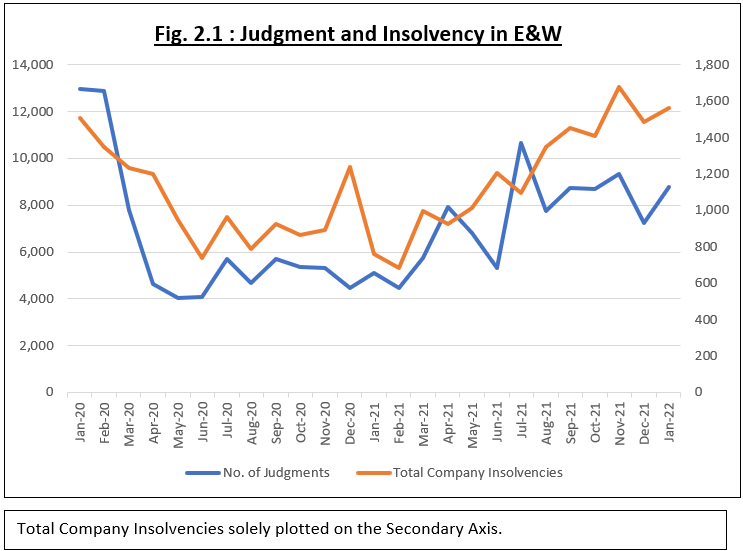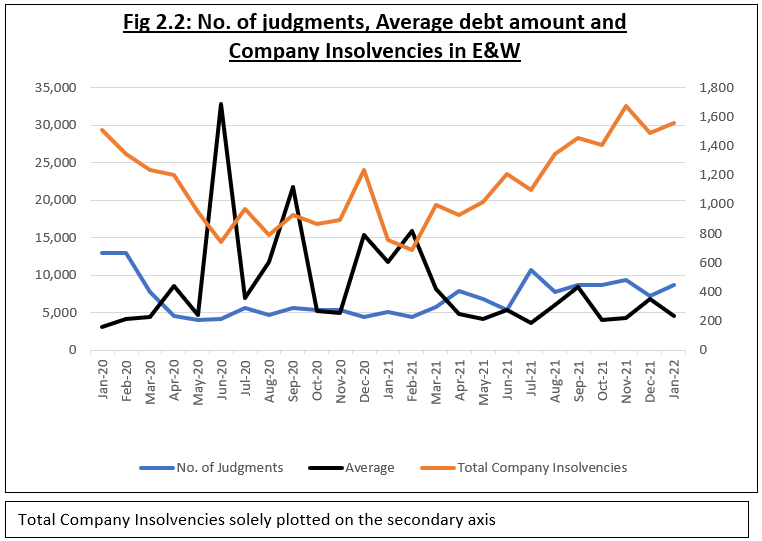Sukanya Guha, Data Analyst, Registry Trust
Thursday, 7th July 2022
Following up on the Registry Trust’s article published in September 2021 which revealed that 78% of businesses became insolvent within 999 days of their first monetary judgment, we would like to revisit the connection between commercial county court judgments (CCJs) and business insolvencies. At Registry Trust, we maintain the Register of Judgments, Orders, and Fines for the UK & Ireland, which allows us to monitor up-to-the-minute levels of indebtedness and financial vulnerability on an ongoing basis.
As confirmed by the figures published in our monetary judgment statistics for the first quarter of 2022, businesses across the UK had a rough start to the year. Our report outlined an increase in business CCJs among all the jurisdictions in Q1 2022. Furthermore, this guest blog from Real Business Rescue highlighted the struggles the small firms are facing following the ‘cost of doing business crisis’.
During the COVID-19 pandemic, government-backed lending schemes helped businesses survive the crisis. The Good Credit Index 2021 by Demos, which uses Registry Trust data, found that credit scores improved by 2.02% on average in 2021, compared to 2020. This positive correlation between government assistance and the financial wellbeing of businesses is reflected in Table 1.1 which reveals that both insolvencies and judgments decreased in Jan 2021 as compared to Jan 2020.

However, as the lockdown restrictions were lifted and government support was no longer an option, the rate of commercial judgments started to rise, and so did the rate of company insolvencies. Real Business Rescue’s quarterly insolvency statistics for Q3 2021 show the highest quarterly insolvency figure since before the pandemic began as business insolvencies increased by 21%.
Table 1.2 shows how early 2022 has revealed the signs of financial distress for businesses with a drastic increase in the monetary judgments and insolvency rates as compared to Jan 2021. These figures not only confirm the connection between the rate of judgments and insolvencies, but also sheds light upon the impact of the government support, and the lack thereof - on the fiscal viability of businesses.

A concerning insight revealed by the above tables is that the decrease in the rate of company insolvencies (50%) in Jan 2021 due to government support is dramatically low as compared to the increase in the insolvency rate (106%) in Jan 2022 in absence of the financial aid from the government.
Also, the relationship between monetary judgment data and insolvency rate stresses the high probability of CCJs being a reliable and an early indicator of business insolvencies. Using CCJs as a gauge to identify businesses in need of intervention to prevent insolvency might prove to be a valuable tool.
Fig. 2.1 shows how the number of commercial judgments and insolvencies in England and Wales, with few exceptions, have a followed a similar pattern over this period.

To explain these exceptions, we are going to consider the average debt value of England & Wales in Fig 2.2.

Fig 2.2 shows that during the months of December 2020 and June 2021, the average value of judgments were higher. Hence, despite having a low number of judgments, the insolvency rate continued to rise during those months. Alternatively, in April 2021 and July 2021, the average judgment value continued to fall which explains the fall in insolvency rate, despite having higher number of judgments.
Based on the recent figures published in an article by Credit Connect, the rate of insolvencies decreased in April in England and Wales by 6%, and as per our data, so did the rate of commercial judgments, by 36%, which strengthens the connection between business debt and insolvencies.
Following the Covid crisis, it was expected that the businesses would overcome the pandemic losses once the restrictions were eased and people started spending more. Unfortunately, the onset of the ‘cost of living’ crisis is not only having a devastating impact on the spending behaviour of consumers, it also has left businesses facing endless financial struggles. The increase in fuel prices and energy costs have forced businesses to increase their prices, which in turn, has made the consumers reluctant to spend more. The consequence of this is businesses operating on losses. Adding to that, the withdrawal of the government support has left many businesses handicapped during this time of economic crisis.
While the UK is facing significant and growing economic challenges, it becomes immensely important to identify the initial signs of financial distress among businesses to prevent their potential insolvency. Hence, a close monitoring of the commercial monetary judgment data held by Registry Trust can play a crucial role in targeting companies which are in immediate need of debt management advice and financial support. Furthermore, financial support from the government is once again required to prevent these already struggling businesses from the catastrophic effects of the current economic crisis.
To keep up to date with the latest from Registry Trust, click here to subscribe to our monthly updates and/or follow us on Twitter and LinkedIn. You can also follow our public website TrustOnline on Facebook and LinkedIn for regular useful updates about CCJs, credit scores and more.